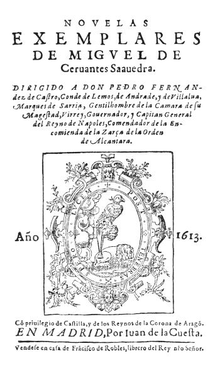Novelas ejemplares
|
1613 edition, with the now archaic spelling "exemplares". | |
| Author | Miguel de Cervantes |
|---|---|
| Original title | 'Novelas exemplares' |
| Country | Spain |
| Language | Spanish |
| Publisher | Juan de la Cuesta |
Novelas ejemplares ("Exemplary Novels") is a series of twelve novellas that follow the model established in Italy,[1] written by Miguel de Cervantes between 1590 and 1612. The collection was printed in Madrid in 1613 by Juan de la Cuesta, and received well in the wake of the first part of Don Quixote.
Cervantes boasted in his foreword to have been the first to write novelas in the Spanish language:
My genius and my inclination prompt me to this kind of writing; the more so as I consider (and with truth) that I am the first who has written novels in the Spanish language, though many have hitherto appeared among us, all of them translated from foreign authors. But these are my own, neither imitated nor stolen from anyone; my genius has engendered them, my pen has brought them forth, and they are growing up in the arms of the press.[2]
The novellas are usually grouped into two series: those characterized by an idealized nature and those of a realistic nature. Those idealized in nature, which are the closest to the Italian models, are characterized by plots dealing with amorous entanglements, by improbable plots, by the presence of idealized characters and psychological development, and the low reflection of reality. They include: El amante liberal, Las dos doncellas, La española inglesa, La señora Cornelia and La fuerza de la sangre. These seré The most popular of the novellas at the time. The realistic in nature cater to the descriptions of realistic characters and environments, with intentional criticism in many cases. The realistic in nature are the best-known stories today: Rinconete y Cortadillo, El licenciado Vidriera, La gitanilla, El casamiento engañoso (which leads directly into the fantasy El coloquio de los perros), and La ilustre fregona. However, the separation between the two groups is not sharp and elements of the idealistic may be found in some of the realistic novels.
Since there are multiple versions of two of these stories, it is believed that Cervantes introduced some variations in these novels for moral, social and aesthetic purposes (hence the name 'exemplary'). The more primitive versions were found in the manuscript, now lost, called by the name of its one-time possessor, Porras de la Cámara, a miscellaneous collection of various literary works which include a novel usually attributed to Cervantes, La tía fingida. On the other hand, some short stories are also embedded in Don Quixote, such as El curioso impertinente or Historia del cautivo, and where a character possesses a manuscript of Rinconete y Cortadillo, unpublished at the time (1605).
Influence and adaptations
Cervantes' novellas inspired several English Jacobean dramas, whose authors might have read them either in French translation or in the Spanish original. Plays based on the novellas include Beaumont and Fletcher's Love's Pilgrimage (adapted from "Las dos doncellas"), Fletcher's The Chances ("La Señora Cornelia"), Fletcher's Rule a Wife and Have a Wife ("El casamiento engañoso"), and Middleton's The Spanish Gypsy ("La fuerza de la sangre" and "La gitanilla"), among others.[3]
The short stories
- La gitanilla
- El amante liberal
- Rinconete y Cortadillo
- La española inglesa
- El licenciado Vidriera
- La fuerza de la sangre
- El celoso extremeño
- La ilustre fregona
- Las dos doncellas
- La señora Cornelia
- El casamiento engañoso
- El coloquio de los perros
Notes
- ↑ "Definition of 'novella'". merriam-webster.com. Retrieved 6 February 2014.
Story with a compact and pointed plot, often realistic and satiric in tone. Originating in Italy during the Middle Ages, it was often based on local events; individual tales often were gathered into collections. The novella developed into a psychologically subtle and structured short tale, with writers frequently using a frame story to unify tales around a theme, as in Giovanni Boccaccio's Decameron.
- ↑ Cervantes Saavedra, Miguel de. "E-book of The Exemplary Novels of Cervantes (Translated by Walter K. Kelly)". The Project Gutenberg. Retrieved 2008-11-04.
- ↑ Wilson 37-45; Ardila, 5.
References
- Ardila, J.A.G., ed. The Cervantean Heritage: Reception and Influence of Cervantes in Britain. London: Legenda, 2009.
- Wilson, E.M. "Cervantes and English Literature of the Seventeenth Century." Bulletin Hispanique 50.1 (1948): 27-52.
External links
| Wikisource has original text related to this article: |
| ||||||
